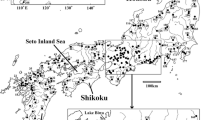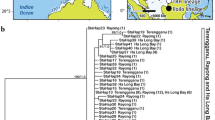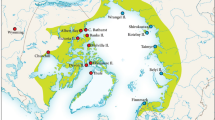Abstract
Phylogeography studies add insights into the geographic and evolutionary processes that underline the genetic divergence of populations. This work examines the geographic genetic structure of the Patagonian blennie, Eleginops maclovinus, a notothenioid (Perciformes) endemic to South American temperate and sub-Antarctic waters, using mitochondrial DNA cytochrome b sequences. We found 58 haplotypes in the analysis of 261 individual sequences of 833 base pairs in length. Among-population variance was very low (1.62%) and many haplotypes were shared between several populations across the species geographic range. Genetic differentiation was not consistent with a simple model of isolation by distance, possibly suggesting a lack of equilibrium between gene flow and local genetic drift. The analysis of mismatch distributions, neutrality tests, and the Bayesian Skyline Plot showed a pattern consistent with a recent population expansion event that may have taken place during the Middle Pleistocene.




Similar content being viewed by others
References
Avise JC (2000) Phylogeography: the history and formation of species. Harvard University Press, Cambridge
Avise J (2004) Molecular markers, natural history and evolution, 2nd edn. Sinauer Associates, Massachusetts
Avise JC (2009) Phylogeography: retrospect and prospect. J Biogeogr 36:3–15
Bandelt HJ, Forster P, Röhl A (1999) Median-joining networks for inferring intraspecific phylogenies. Mol Biol Evol 16(1):37
Brickle P, Laptikhovsky V, Arkhipkin A (2005) Reproductive strategy of a primitive temperate notothenioid Eleginops maclovinus. J Fish Biol 66(4):1044–1059
Calvo J, Morriconi E, Rae GA, San Román NA (1992) Evidence of protandry in a sub-Antarctic nototheniid Eleginops maclovinus (Cuv. & Val. 1830) from the Beagle Channel, Argentine. J Fish Biol 40:157–162
Ceballos SG, Victorio MF, Lyra ML, Fernández DA (2011) Isolation and characterization of ten microsatellite loci from the Patagonian notothenioid fish Eleginops maclovinus. Conserv Genet Resour 3:689–691
Chopelet J, Waples RS, Mariani S (2009) Sex change and the genetic structure of marine fish populations. Fish Fish 10(3):329–343
Clapperton CM (1993) Quaternary geology and geomorphology of South America, vol 779. Elsevier, Amsterdam
Clarke A, Johnston IA (1996) Evolution and adaptative radiation of Antarctic fishes. TREE 11(5):212–217
Coronato AMJ, Martínez O, Rabassa J (2004) Glaciations in Argentine Patagonia, Southern South America. In: Ehlers J, Gibbard P (eds) Quaternary glaciations: extent and chronology. Part III: South America, Asia, Africa, Australia and Antarctica. Quaternary book series. Elsevier, Amsterdam, pp 49–67
Cousseau MB, Perrotta R (2000) Peces Marinos de Argentina. INIDEP, Mar del Plata
Cuvier G, Valenciennes A (1830) Histoire naturelle des poissons, vol 1. F.-G. Levrault
Drummond AJ, Rambaut A (2007) BEAST: Bayesian evolutionary analysis by sampling trees. BMC Evolut Biol 7(1):214
Drummond AJ, Rambaut A, Shapiro B, Pybus OG (2005) Bayesian coalescent inference of past population dynamics from molecular sequences. Mol Biol Evol 22(5):1185
Eastman JT (2000) Antarctic Notothenioid fishes as subjects for research in evolutionary biology. Antarct Sci 12(3):276–287
Eastman J (2005) The nature of the diversity of Antarctic fishes. Polar Biol 28:93–107
Eastman JT, Lannoo MJ (2008) Brain and sense organ anatomy and histology of the Falkland Islands mullet, Eleginops maclovinus (Eleginopidae), the sister group of the Antarctic notothenioid fishes (Perciformes: Notothenioidei). J Morphol 269(1):84–103
Excoffier L (2004) Patterns of DNA sequence diversity and genetic structure after a range expansion: lessons from the infinite island model. Mol Ecol 13(4):853–864
Excoffier L, Laval G, Schneider S (2005) Arlequin ver. 3.0: an integrated software package for population genetics data analysis. Evol Bioinform Online 1:47–50
Goodall RNP, Galeazzi AR (1985) A review of the food habits of the small cetaceans of the Antarctic and Sub-Antarctic. Antarctic nutrient cycles and food webs. Springer-Verlag, Berlin
Gosztonyi AE (1974) Edad y crecimiento del róbalo Eleginops maclovinus (Osteichthyes, Nototheniidae) en aguas de la ria Deseado y sus adyacencias. Physis 33(86):1–8
Gosztonyi A (1980) Biología del róbalo (Eleginops maclovinus Cuv. & Val., 1830). Universidad Nacional de La Plata, La Plata
Hall TA (1999) BioEdit: A user-friendly biological sequence alignment editor and analysis program for Windows 95/98/NT. Nucl Acids Symp Ser 41:95–98
Hartl DL, Clark AG (2007) Principles of population genetics. 4th edn. Sinauer associates, Sunderland
Hein AS, Hulton NRJ, Dunai TJ, Schnabel C, Kaplan MR, Naylor M, Xu S (2009) Middle Pleistocene glaciation in Patagonia dated by cosmogenic-nuclide measurements on outwash gravels. Earth Planet Sci Lett 286(1–2):184–197
Isla MS, San Román NA (1995) Alimentación de Eleginops maclovinus (Pisces, Nototheniidae) en el Canal Beagle, Argentina. Naturalia Patagónica 3:107–127
Jakob SS, Martinez-Meyer E, Blattner FR (2009) Phylogeographic analyses and paleodistribution modeling indicate Pleistocene in situ survival of Hordeum species (Poaceae) in southern Patagonia without genetic or spatial restriction. Mol Biol Evol 26(4):907
Janko K, Lecointre G, DeVries A, Couloux A, Cruaud C, Marshall C (2007) Did glacial advances during the Pleistocene influence differently the demographic histories of benthic and pelagic Antarctic shelf fishes?—Inferences from intraspecific mitochondrial and nuclear DNA sequence diversity. BMC Evol Biol 7(1):220
Jost L (2008) GST and its relatives do not measure differentiation. Mol Ecol 17(18):4015–4026
Kaplan MR, Douglass DC, Ackert RP, Caffee MW (2005) Cosmogenic nuclide chronology of pre-last glaciation maximum moraines at Lago Buenos Aires, 46 S. Argentina Quat Res 63:301–315
Lessa EP, D’Elía G, Pardiñas UFJ (2010) Genetic footprints of late Quaternary climate change in the diversity of Patagonian Fueguian rodents. Mol Ecol 19(15):3031–3037
Librado P, Rozas J (2009) DnaSP v5: a software for comprehensive analysis of DNA polymorphism data. Bioinformatics 25(11):1451
Licandeo RR, Barrientos CA, González MA (2006) Age, growth rates, sex change and feeding habits of notothenioid fish Eleginops maclovinus from the central-southern Chilean coast. Environ Biol Fish 77:51–61
Martin JP, Bastida R (2008) Contribution of benthic communities to the diet of the Patagonian blenny (Eleginops maclovinus) at Ría Deseado (Santa Cruz, Argentina). Lat Am J Aquat Res 36(1):1–13
Matschiner M, Hanel R, Salzburger W (2009) Gene flow by larval dispersal in the Antarctic notothenioid fish Gobionotothen gibberifrons. Mol Ecol 18(12):2574–2587
Matschiner M, Hanel R, Salzburger W (2011) On the origin and trigger of the notothenioid adaptive radiation. PLoS ONE 6(4):e18911
Miller SA, Dikes DD, Polesky HF (1988) A simple salting procedure for extracting DNA from human nucleated cells. Nucleic Acids Res 16:215
Near TJ (2004) Estimating divergence times of notothenioid fishes using a fossil-calibrated molecular clock. Antarct Sci 16(1):37–44
Near TJ, Cheng CHC (2008) Phylogenetics of notothenioid fishes (Teleostei: Acanthomorpha): inferences from mitochondrial and nuclear gene sequences. Mol Phylogenet Evol 47(2):832–840
Pequeño G (1989) The geographical distribution and taxonomic arrangement of South American Nototheniid fishes (Osteichthyes, Nototheniidae). Bol Soc Biol Concepci¢n 60:183–200
Pequeño G, Pavés H, Bertrán C, Vargas-Chacoff L (2010) Seasonal limnetic feeding regime of the”robalo” Eleginops maclovinus (Valenciennes 1830), in the Valdivia river, Chile. Gayana (Concepc) 74(1):47–56
Posada D (2008) jModelTest: phylogenetic model averaging. Mol Biol Evol 25(7):1253
Rabassa J (2008) Late cenozoic glaciations in Patagonia and Tierra del Fuego. Dev Quat Sci 11:151–204
Ramos-Onsins SE, Rozas J (2002) Statistical properties of new neutrality tests against population growth. Mol Biol Evol 19(12):2092
Ruzzante DE, Walde SJ, Gosse JC, Cussac VE, Habit E, Zemlak TS, Adams EDM (2008) Climate control on ancestral population dynamics: insight from Patagonian fish phylogeography. Mol Ecol 17(9):2234–2244
Scher HD, Martin EE (2006) Timing and climatic consequences of the opening of Drake Passage. Science 312(5772):428
Schneider S, Excoffier L (1999) Estimation of past demographic parameters from the distribution of pairwise differences when the mutation rates vary among sites: application to human mitochondrial DNA. Genetics 152(3):1079
Slatkin M, Barton NH (1989) A comparison of three indirect methods for estimating average levels of gene flow. Evolution 43(7):1349–1368
Slatkin M, Hudson RR (1991) Pairwise comparisons of mitochondrial DNA sequences in stable and exponentially growing populations. Genetics 129(2):555–562
Smith MF, Patton JL (1991) Variation in mitochondrial cytochrome b sequence in natural populations of South American akodontine rodents (Muridae: Sigmodontinae). Mol Biol Evol 8(1):85
Vanella F, Calvo J (2005) Influence of temperature, habitat and body mass an routine metabolic rates of sub-antarctic teleosts. Scientia Marina 69(2):317–323
Waples RS (1998) Separating the wheat from the chaff: patterns of genetic differentiation in high gene flow species. J Hered 89(5):438
Ward RD, Woodwark M, Skibinski DOF (1994) A comparison of genetic diversity levels in marine, freshwater, and anadromous fishes. J Fish Biol 44(2):213–232
Whitlock MC, McCauley DE (1999) Indirect measures of gene flow and migration: FST 1/(4Nm + 1). Heredity 82(2):117–125
Xu J, Pérez Losada M, Jara CG, Crandall KA (2009) Pleistocene glaciation leaves deep signature on the freshwater crab Aegla alacalufi in Chilean Patagonia. Mol Ecol 18(5):904–918
Zemlak TS, Habit EM, Walde SJ, Carrea C, Ruzzante DE (2010) Surviving historical Patagonian landscapes and climate: molecular insights from Galaxias maculatus. BMC Evolut Biol 10(1):67
Acknowledgments
This work was founded by grants from the Agencia Nacional de Promoción Científica y Tecnológica (PICT906) and Proyectos Federales de Innovación Productiva 2007 (PFIP 1622/07). We would like to specially thank Roberto Licandeo for sampling support. We also thank Juan Federico Ponce (CADIC-CONICET), María Natalia Paso Viola (MACN-CONICET), Alejandro D’Anatro and Carolina Abud from Universidad de la República, Montevideo, Ururguay, for their constant technical support and advice.
Author information
Authors and Affiliations
Corresponding author
Additional information
Communicated by M. I. Taylor.
Electronic supplementary material
Below is the link to the electronic supplementary material.
Rights and permissions
About this article
Cite this article
Ceballos, S.G., Lessa, E.P., Victorio, M.F. et al. Phylogeography of the sub-Antarctic notothenioid fish Eleginops maclovinus: evidence of population expansion. Mar Biol 159, 499–505 (2012). https://doi.org/10.1007/s00227-011-1830-4
Received:
Accepted:
Published:
Issue Date:
DOI: https://doi.org/10.1007/s00227-011-1830-4




